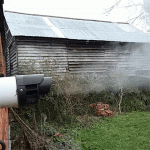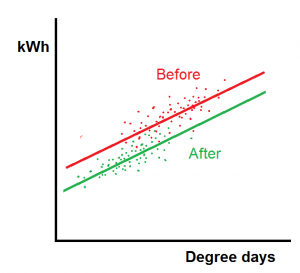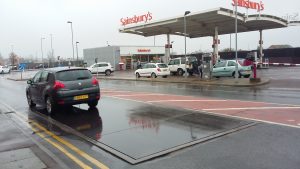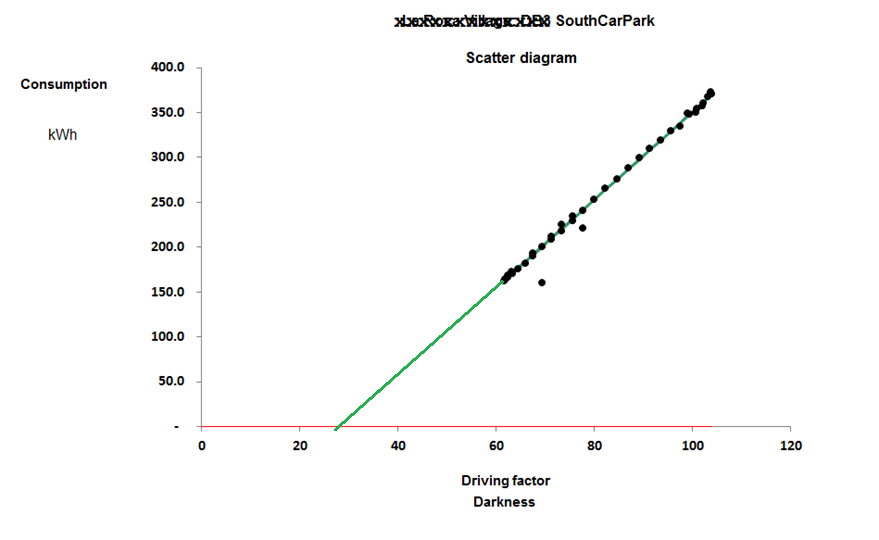 Absorption chiller: Cooling apparatus driven by heat alone
Absorption chiller: Cooling apparatus driven by heat alone
Accuracy: Degree to which a measurement reflects actual reality
AHU: See Air handling unit
Air curtain: Sheet of heated air projected across an open doorway to prevent discomfort from draughts; usually in retail premises
Air handling unit: Air handling unit: assembly of fan, filters, etc for supplying air to or extracting air from a ducted distribution system
Ammeter: Instrument for measuring electric current
amp (A): Unit of measurement of electric current
AMR: Automatic meter reading
Anemometer: Device to measure air velocity
Audit, energy: Systematic review of energy-using systems and associated procedures with a view to identifying opportunities for energy saving
For training in energy management topics see vesma.com/training
Ballast: Component of electrical control gear in a fluorescent light fitting.
BEMS: Building energy management system: computerised control and monitoring equipment for regulating time and temperature schedules etc
BEMS: See Building energy management system
Blending valve: See Mixing valve
Blowdown: Removal of a fraction of boiler water to enable removal of sludge and dilution of dissolved solids
BMS: See Building energy management system
Building energy management system: Computer system which controls the operation of heating, ventilation, air conditioning, lights and other energy services in buildings
For training in energy management topics see vesma.com/training
Calorific value: Energy content of fuel per unit mass or volume
Capacity charge: Rental paid for an electrical supply connection capable of carrying a certain current
CFL: Compact fluorescent lamp: plug-in substitute for a light bulb.
Chiller: Machine for cooling air, water, etc
CHP: See Combines heat and power
CNG: Compressed natural gas
Code 5: In UK context, a meter for registering half-hourly electricity consumption for loads above 100 kW
Coefficient of performance: In refrigeration systems, the ratio of output cooling power to input electrical power.
Cogeneration: See Combined heat and power
Colour rendering: How effective a given light source is at allowing discrimination between colours
Colour temperature: Numerical value describing a light source in terms of how ‘warm’ or ‘cool’ it appears
Combined heat and power: Electricity generation in which part of the waste heat is put to use
Compensator: Control device to regulate circulating water temperature in a heating system, reducing temperature when heat demand is low and vice versa
Condensate: Water resulting from the cooling of steam
Condenser: In a refrigeration circuit, the component through which heat is rejected.
Conduction losses: Heat losses through the walls, roof, floors, doors, windows and other solid elements of the building envelope.
Constant temperature: In heating system, regime in which circulating water is maintained at a fixed temperature and control of heat output is effected by regulating flow to heat emitters
Convection losses: Heat lost in air leaving the building through draughts and deliberate ventilation
Convector, fan assisted: Heat emitter on a central heating system in which a fan blows room air across a heat exchanger
Convector, natural: Heat emitter on a central heating system, usually enclosed in a cabinet with inlet and outlet vents, which warms room air without the assistance of a fan
Cooling tower: Device in which water used for cooling something gives up some of its heat to the air, enabling it to be recirculated in a closed loop. May be ‘dry’, employing a sealed heat exchanger, or ‘wet’ in which case evaporation of the water increases the cooling effect
CoP: See Coefficient of performance
Coriolis meter: Technology for measuring the flow rate of for example dust-laden gases; the flow rate affecting the resonant frequency of a U-shaped section of vibrating pipe
Correction factor: In the context of natural gas, the factor by which its metered volume must be multiplied to account for its pressure and temperature being other than that assumed as standard
CT: In heating system: see Constant temperature; in metering see Current transformer
Current: Rate of flow of electrical energy
Current transformer: Device placed around one conductor of an electrical supply cable to convert the current flowing in it into a safely-measurable signal for input to a meter
Cusum: Cumulative sum of deviance
CV: See Calorific value
For training in energy management topics see vesma.com/training
Damper: Flap used to control air flow in a duct
Data logger: Device for recording data from energy meters, temperature probes and other instruments
Dead band: Switching differential between for example the activation of heating and cooling in a space; sometimes in a thermostatic control the spread between temperatures that trigger changes of state each way between on and off.
Degree days: Measure of how hot or cold the weather was over a given interval, typically a week or month, in a given location or region. Used in an analogous fashion to production output as the driving factor for heating opr air-conditioning energy consumption.
Deliquescent: Dessicant material which dissolves in the water it absorbs
Delta: Connection method for three-phase devices where the load is connected from phase to phase without a neutral (cf star)
Demand, maximum: See Maximum demand
Dessicant: Material which absorbs water vapour; used for example in compressed-air dryers
Deviance : Difference between actual and expected consumption
Dew point: Air temperature at which moisture will begin to condense; also known as saturation temperature
Dichroic: Attribute of a filament spotlamp whereby the reflector allows heat to escape through the back
Direct-fired heater: Heater in which fuel is used directly, as distinct from a heat emitter on a hot-water or steam circuit with centralised combustion.
Discounted cash flow: Method of accounting for future expenditure and receipts which explicitly recognises that postponing a cash flow diminishes its value in present terms
Driving factor: Recurrent and measurable determinant of energy consumption, such as production output or degree-day value.
Dry cycling: Excessive starting and stopping of boilers, especially when supporting each other’s standing losses
For training in energy management topics see vesma.com/training
Economiser: Heat recovery unit specifically for preheating boiler water from heat in exhaust gases
Efficiency: The ratio of useful output to energy input
Electronically-commutated motor: machine, typically for DC or single-phase AC supplies, which turns a permanent-magnet rotor by synthesising of a rotating magnetic field
Embedded generation: Electricity generator owned and operated by the organisation which uses the output
EMS: See Building energy management system
Energy: Electricity, gas, oil, steam, compressed air or other like medium
Energy performance coefficient: ratio of actual to expected consumption; a numerical index of energy performance much less susceptible to distortion than specific energy ratio
Enthalpy: Total energy content of a fluid, representing both thermal and mechanical energy that could be extracted from it
Enthalpy control: Control regime in air-conditioning systems to optimise the energy requirement for regulating both humidity and temperature
Evaporator: In a refrigeration circuit, the component through which heat is absorbed
Expected consumption: rational estimate, either based on the known previous relationship between consumption and one or more relevant driving factors , or calculated from first principles
For training in energy management topics see vesma.com/training
Far infra-red: ill-defined term most commonly associated with fake energy-saving products; usually denoting heat radiated from surfaces at no more than about 80°C
Firetube: Boiler design in which combustion gases pass through submerged tubes
Flash steam: Steam resulting when hot condensate is dropped to a lower pressure
Flue: Duct through which combustion products pass en route to the chimney
Flue gas: Combustion products
Fluidised bed: Combustion not in an open flame but within a bed of loose powder
Forced draught: Fans which drive combustion air into a boiler (cf Induced draught)
Free cooling: Cooling effect achieved by drawing in cold fresh air rather than chilling recirculated air
Frost protection: Automatic application of heat to prevent freezing damage out of hours
For training in energy management topics see vesma.com/training
GCV: See Gross calorific value
Geothermal energy: Heat drawn from deep underground at sufficiently high temperature to be directly useable (cf Ground-source heat pump)
GLS: General lighting service: conventional filament lamp
Gross calorific value: Total chemical energy content of a fuel, including what would be recovered by condensing the water vapour from the products of combustion. Also called higher calorific value. Cf Nett calorific value.
Ground-source heat pump: Reverse refrigeration cycle which cools the ground in order to provide a heating effect from its condenser (cf Geothermal energy)
GSHP: See Ground-source heat pump
For training in energy management topics see vesma.com/training
HCV: See Gross calorific value
Heat: Thermal energy which can raise something’s temperature, or melt or boil it.
Heat emitter: Radiator, convector, or other device delivering heat in a heating system
Heat exchanger: Device within which a hot fluid stream gives up heat to a cold stream while maintaining separation between the two
Heat map: Graphical display of profile data in which for example demand levels are depicted as colour contours on a matrix in which each column represents one day, midnight to midnight.
Heat pipe: Closed length of tube containing a small charge of volatile liquid and a wick; transfers heat end to end through fluid boiling at one end and condensing at the other, returning via the wick
Heat pump: Refrigeration unit operated in reverse, providing heat at moderate temperature by cooling either the outside air or the ground nearby.
Heat wheel: Form of regenerative heat recovery in which the heat storage matrix is in the form of a wheel rotating continuously between the hot and cold streams.
hertz (Hz): Unit of measurement of frequency: cycles per second
Higher calorific value: See Gross calorific value
Historical baseline performance characteristic: Performance characteristic which applied at the outset of the energy management campaign
For training in energy management topics see vesma.com/training
Incidental gains: Heat gains in a building arising from lights, equipment, uninsulated hot surfaces, occupants, sunshine etc..
Induced draught: Fans which draw exhaust gases from a boiler (cf Forced draught)
Inhibitor: Chemical additive in boiler water to reduce corrosion
Insulation: Material which reduces the conduction of heat
Inverter: Electrical device for converting direct to alternating current; component of a variable-speed drive
joule (J): Unit of energy: one watt-second
For training in energy management topics see vesma.com/training
kelvin: (K) unit of temperature difference
Landfill gas: Methane emanating from waste-disposal sites and collected as a fuel
Latent heat: Heat required to melt or vaporise a substance; or heat released when a vapour condenses or a liquid solidifies. Notwithstanding the release or absorption of heat, the change of state between liquid and solid or vapour occurs without a change of temperature.
Load factor: Ratio between actual output or input and the maximum theoretically possible with continuous operation at full output or input.
Logger: See Data logger
LPG: Liquefied petroleum gas
lumen: Unit of light output power
Luminaire: Light fitting including reflector, lamp holder, control gear and lens etc
lux: Measure of the light incident on a surface per unit area
LV: Low voltage
For training in energy management topics see vesma.com/training
M&T: See Monitoring and targeting
Maximum demand: In UK context, the peak electrical power drawn over any half-hour period in a month
Mercury discharge: Type of fluorescent lamp typically used for floodlighting
Metal halide: Type of filament lamp
Mixing valve: In a Variable temperature heating circuit, the valve which regulates flow temperature by blending water from the boiler(s) with cooler water returning from the heating system. Also called a three-port valve as it has two inputs and one output connection.
Monitoring and targeting: Systematic assessment of actual against expected consumption by means of weekly (usually) overspend league table augmented by analysis tools to assist in target-setting and diagnosis of abnormal performance.
Motorised valve: Valve actuated by an electric motor under the dictates of a control system
MV: See motorised valve
For training in energy management topics see vesma.com/training
Night blind: Insulating blind on chilled display cabinet to reduce cooling requirement out of hours,
NOx: Oxides of nitrogen generated as a by-product of combustion
NTP: Normal temperature and pressure: reference used for correcting volumes and densities (0°C and 1.013 bar); cf STP, RTP
For training in energy management topics see vesma.com/training
Optimum start: Time-control regime which postpones startup, usually of heating boilers, to the latest possible time commensurate with achieving desired internal conditions at the required time.
Orifice plate: Restriction placed in a gas, air, or steam line to create a measurable pressure drop from which flow arte can be inferred
OSC: Optimum start control
Overspend league table: Weekly (usually) or monthly report in which deviations from expected consumption are ranked in descending order of excess cost.
For training in energy management topics see vesma.com/training
Passive infra-red: Technique for detecting the presence of people in a space
Performance characteristic: Mathematical relationship between energy consumption and one or more driving factors
Phase: Alternating-current electrical supplies are either single-phase (delivered through one pair of wires) or three-phase (delivered through three wires, the current waveform in each being one-third of a cycle behind or ahead of the others).
PIR: See Passive infra-red
Polyphase: arrangement of electrical supply in which (most commonly) three lines are energised by alternating current one-third of a cycle apart
Power: Rate of flow of energy
Power factor: In alternating-current electrical supplies, the ratio of useful power delivered to the theoretical maximum possible for the given current and voltage
Precision: Degree of resolution in a measurement
Profile: Pattern of demand over a day, week, or other chosen interval.
For training in energy management topics see vesma.com/training
Radiant: Heat transfer without physical contact
Receiver: Pressure vessel for storing compressed air.
Recuperator: Heat-recovery device
Reflective: property of material e.g. aluminium foil which impedes the flow of radiated energy across a transparent medium
Refractory: High-temperature insulation found in furnaces and kilns
Regenerator: In heat recovery, a pair (usually) of heat stores which take it in turns to collect heat from a hot stream and return it to a cold stream
Regression line: Best-fit line through points on a scatter diagram
Relative humidity: The ratio between the amount of water vapour present in the air and the theoretical maximum at the prevailing temperature
Repeatability: Degree to which measurements vary consistently irrespective of accuracy
Rewind: Repair of electric motor by replacement of burned-out windings
RTP: Reference temperature and pressure used for correcting volumes and densities (25°C and 1.013 bar) cf NTP, STP
Run-around coil: Split heat-recovery system in which heat is recovered to an intermediate fluid circuit, allowing heat collection and delivery to be in different places
For training in energy management topics see vesma.com/training
Sankey diagram: Diagrammatic representation of energy flows through a process or organisation in which the magnitudes of flows are represented by the widths of pathways
Saturation temperature: See Dew point
SCADA: See Supervisory, control and data acquisition
Scatter diagram: Chart showing the relationship between one value and another: commonly showing weekly energy use (vertical or x axis) against driving factor (horizontal or y axis)
Sensible heat: Heat which when added to or removed from a body, alters its temperature
Sequencing: Usually of boilers but also applicable to chillers, compressors, and other ganged utility equipment: a control regime which regulates how many units are enabled so as to match the load.
Smart meter: Consumption meter which is capable of recording data at frequent intervals for onward transmission, normally with two-way communication to facilitate remote disconnection of the user, reporting, etc
Smoke pump: Device to measure the level of soot present in flue gases when testing oil and coal-fired appliances
SON: Sodium discharge lamp giving a pure yellow light (commonly used for street lighting)
Specific energy ratio: simple ratio of energy input to (usually) product output. Supposedly an indicator of energy performance but highly susceptible to distortion.
Specific heat: Property of a material expressing the amount of heat required to raise its temperature by one degree
Stack: Chimney
Stand-alone control: Time or temperature control device that operates independently (as distinct from an Outstation)
Standing loss: Incidental heat loss from equipment incurred regardless of demand
Star: Connection method for three-phase devices where the load is connected between each phase and neutral (cf delta)
STP: Standard temperature and pressure: reference used for correcting volumes and densities (15.5°C and 1.013 bar); cf NTP, RTP
Sun pipe: Internally-reflective tube used to conduct daylight into an internal space where conventional rooflights cannot be used.
Supervisory, control and data acquisition: Computerised control and monitoring equipment for industrial process plant
Survey, energy: Review of energy-using systems with a view to identifying opportunities for energy saving
Switching differential: See Dead band
Synchronous motor: AC machine with permanent-magnet rotor which rotates exactly at supply frequency or submultiple thereof; absence of rotor winding giving reduced losses
For training in energy management topics see vesma.com/training
Target performance characteristic: Performance characteristic representing the best achievable consumption relative to appropriate driving factors
Tariff: Table of charges; typically understood as applying to supplies other than those negotiated under contract
TDS: See Total dissolved solids
Temperature: Measure of how hot something is
Thermocouple: Temperature-measuring device exploiting the small voltage developed when a junction between dissimilar metals is heated
Thermostatic radiator valve: Direct-acting device for regulating heat output from a radiator
Three-port valve: See Mixing valve and diverting valve
Total dissolved solids: Measure of the concentration of dissolved salts in boiler water
Trace heating: Heating applied to pipes in order to prevent the contents solidifying
Transformer: Device for converting alternating-current electricity from one voltage to another.
TRV: See Thermostatic radiator valve
Turbine: Rotating device for converting (typically) steam into mechanical power; also found on a small scale as a fluid-metering technology
Two-port valve: Straight-through valve giving on/off or regulated flow
For training in energy management topics see vesma.com/training
U-value: Property of an element of the building envelope expressing how easily heat flows through it per square metre of surface area
Vapour-compression chiller: Cooling apparatus driven by mechanical power
Variable air volume: Regime for ventilation air distribution where the supply of cooling is regulated by changing the volume of air distributed
Variable refrigerant volume: Regime for regulating cooling power in an air conditioning system
Variable temperature: In heating system, regime in which the circulating water temperature is varied to limit heat output according to likely demand (see also Compensator)
Variable-speed drive: Electronic device which alters the mains frequency fed to an electric motor, causing it to rotate at a different speed
VAV: See Variable air volume
Venting: Removal of air from, for example, steam circuits
Venturi: Tapering constriction in pipework used as a means of inferring flow rate from the pressure drop in the throat
Viscosity: Property of a fluid which determines its resistance to flow
volt (V): Unit of measurement of electric potential or driving force
Vortex meter: Gas, air or steam meter in which flow rate is inferred from the frequency of eddies shed by the fluid passing over a bluff body
VRV: See Variable refrigerant volume
VSD: See Variable-speed drive
VT: See Variable temperature
watt (W): Unit of power
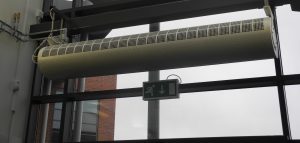 In situations where it is necessary to keep a building’s outer doors open, you will sometimes find “air curtains”, fans which blow a sheet of air down across the width of the doorway. These are an effective way of preventing dust and insects getting in through the door: they are entrained in the outer layer of airflow, and where the jet hits the floor it splits, with the outer layer discharging the contaminants back outside.
In situations where it is necessary to keep a building’s outer doors open, you will sometimes find “air curtains”, fans which blow a sheet of air down across the width of the doorway. These are an effective way of preventing dust and insects getting in through the door: they are entrained in the outer layer of airflow, and where the jet hits the floor it splits, with the outer layer discharging the contaminants back outside.
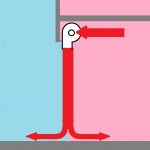 However, even in still conditions there is a problem here, because the fan is drawing air from high level inside and at floor level only half of it returns inside. 50% of the internal air drawn into the fan is diverted outside when the jet splits at floor level (left).
However, even in still conditions there is a problem here, because the fan is drawing air from high level inside and at floor level only half of it returns inside. 50% of the internal air drawn into the fan is diverted outside when the jet splits at floor level (left).